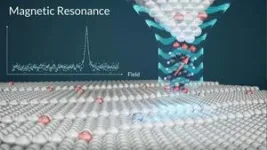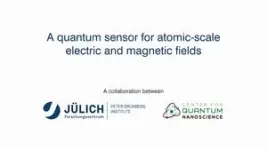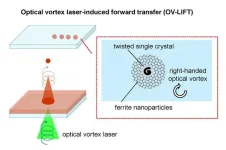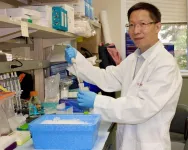(Press-News.org) In a scientific breakthrough, an international research team from Germany's Forschungszentrum Jülich and Korea's IBS Center for Quantum Nanoscience (QNS) developed a quantum sensor capable of detecting minute magnetic fields at the atomic length scale. This pioneering work realizes a long-held dream of scientists: an MRI-like tool for quantum materials.
The research team utilized the expertise of bottom up single-molecule fabrication from the Jülich group while conducting experiments at QNS, utilizing the Korean team’s leading-edge instrumentation and methodological know how, to develop the world's first quantum sensor for the atomic world.
The diameter of an atom is a million times smaller than the thickest human hair. This makes it extremely challenging to visualize and precisely measure physical quantities like electric and magnetic fields emerging from atoms. To sense such weak fields from a single atom, the observing tool must be highly sensitive and as small as the atoms themselves.
A quantum sensor is a technology that uses quantum mechanical phenomena such as the spin of an electron or the entanglement of quantum states for precise measurements. Several types of quantum sensors have been developed over the past years. While many quantum sensors are able to sense electric and magnetic fields, it was believed that atomic-scale spatial resolution cannot be mastered simultaneously.
A new approach for improved resolution
The success of the new atomic-scale quantum sensor lies in the use of one single molecule. This is a conceptionally different way of sensing, since the function of most other sensors relies on a defect – an imperfection – of a crystal lattice. Since such defects develop their properties only when they are deeply embedded into the material, the defect – capable of sensing electric and magnetic fields, will always remain at a rather large distance from the object preventing it to see the actual object on the scale of single atoms.
The research team changed the approach and developed a tool that uses a single molecule to sense electric and magnetic properties of atoms.The molecule is attached to the tip of the scanning tunneling microscope and can be brought within a few atomic distances of the actual object.
Dr. Taner Esat, lead author of the Jülich team, expressed his excitement about the potential applications, stating, "This quantum sensor is a game changer, because it provides images of materials as rich as an MRI and at the same time sets a new standard for spatial resolution in quantum sensors. This will allow us to explore and understand materials at their most fundamental level." The long term collaboration hinged on Dr Esat, previously a post doc at QNS, who moved back to Jülich where he conceived of this sensing molecule. He chose to return to QNS for a research stay in order to prove this technique using the center's cutting-edge instruments.
The sensor has an energy resolution that allows for detecting changes in magnetic and electric fields with a spatial resolution on the order of a tenth of an angstrom, where 1 Ångström typically corresponds to one atomic diameter. Moreover, the quantum sensor can be constructed and implemented in existing laboratories worldwide.
The sensor has an energy resolution that allows for detecting changes in magnetic and electric fields with a spatial resolution on the order of a tenth of an angstrom, where 1 Ångström typically corresponds to one atomic diameter. Moreover, the quantum sensor can be constructed and implemented in existing laboratories worldwide.
"What makes this achievement so striking is that we use an exquisitely engineered quantum object to resolve fundamental atomic properties from the bottom up. Preceding techniques for visualizing materials use large, bulky probes to try to analyze tiny atomic features," stresses QNS’s lead author Dr. Dimitry Borodin. "You have to be small to see small."
This groundbreaking quantum sensor is poised to open up transformative avenues for engineering quantum materials and devices, designing new catalysts, and exploring the fundamental quantum behavior of molecular systems, such as in biochemistry.
Groundbreaking potential
As Yujeong Bae, QNS’s PI for the project, noted, "The revolution in tools for observing and studying matter emerges from the accumulated basic science. As Richard Feynman said, 'There's plenty of room at the bottom,' the potential of technology for manipulating at the atomic level is infinite." And Professor Temirov, research group leader in Jülich, adds: “It is exciting to see how our long-standing work in molecular manipulation has resulted in the construction of a record-holding quantum device.”
The research results were published in Nature Nanotechnology. The development of this atomic-scale quantum sensor marks a significant milestone in the field of quantum technology and is expected to have far-reaching implications across various scientific disciplines.
END
Quantum sensor for the atomic world developed through international scientific collaboration
2024-07-25
ELSE PRESS RELEASES FROM THIS DATE:
The research was wrong: study shows moderate drinking won’t lengthen your life
2024-07-25
PISCATAWAY, NJ – Probably everyone has heard the conventional wisdom that a glass of wine a day is good for you--or you’ve heard some variation of it. The problem is that it’s based on flawed scientific research, according to a new report in the Journal of Studies on Alcohol and Drugs.
Over the years, many studies have suggested that moderate drinkers enjoy longer lives with lower risks of heart disease and other chronic ills than abstainers do. That spurred the widespread belief that alcohol, in moderation, can be a health tonic. However, not all studies have painted such a rosy picture--and the ...
Save your data on printable magnetic devices? New laser technique’s twist might make this reality
2024-07-25
The proliferation of all things digital doesn’t mean that printing technology is no longer relevant. In fact, printing technology is required to make the semiconductors necessary for the digital world. And as an Osaka Metropolitan University-led team has shown using a new printing technique, printable magnetic devices for high-density data storage might soon be realized.
Dr. Ken-ichi Yuyama, a lecturer at the Graduate School of Science, and his colleagues report in APL Materials on the development of a new type of laser-induced forward transfer ...
Early onset dementia more common than previously reported – the incidence of Alzheimer’s disease seems to be on the rise
2024-07-25
A new major study by the University of Eastern Finland, the University of Oulu and Neurocenter Finland explored early-onset dementia in the working-age population in Finland. The study cohort was one of the largest in the world to date, and the findings were published on 24th of July 2024 in Neurology®, the medical journal of the American Academy of Neurology.
Current epidemiological data on early-onset dementia is scarce and based on small study cohorts, with no recent data from Finland available. For the present ...
Pesticides potentially as bad as smoking for increased risk in certain cancers
2024-07-25
In modern day agriculture, pesticides are essential to ensure high enough crop yields and food security. These chemicals, however, can adversely affect plant and animal life as well as the people exposed to them.
Now, in a population-based, nation-wide study, researchers in the US have put increased cancer risk through agricultural pesticide use into context with smoking, a better understood cancer risk factor. The results were published in Frontiers in Cancer Control and Society.
“In our study we found that for some cancers, the effect of agricultural pesticide usage is comparable in magnitude to the effect of smoking,” said the study’s ...
NUS researchers develop new battery-free technology to power electronic devices using ambient radiofrequency signals
2024-07-25
Ubiquitous wireless technologies like Wi-Fi, Bluetooth, and 5G rely on radio frequency (RF) signals to send and receive data. A new prototype of an energy harvesting module – developed by a team led by scientists from the National University of Singapore (NUS) – can now convert ambient or ‘waste’ RF signals into direct current (DC) voltage. This can be used to power small electronic devices without the use of batteries.
RF energy harvesting technologies, such as this, is essential as they reduce battery dependency, extend device lifetimes, minimise environmental impact, and enhance the feasibility of wireless sensor networks and IoT devices in remote ...
New protein discovery may influence future cancer treatment
2024-07-25
Researchers from the University of Otago, Christchurch, have spearheaded the discovery of a protein function which has the potential to guide the development of novel cancer treatment options and improve the diagnosis of various cancers.
The exciting research finding, carried out alongside Dr Vanessa Morris from the University of Canterbury’s School of Biological Sciences as well as researchers in Australia and Denmark, centres on the activity of a tumour- suppressing protein called p16.
The discovery, published in the British scientific journal Nature Communications and first authored by ...
Timing matters: Scripps Research study shows ways to improve health alerts
2024-07-25
LA JOLLA, CA—When seemingly healthy people receive an alert from a wearable sensor telling them they might have a respiratory virus—based on small changes in their unique heartrate, sleep and activity patterns—what do they do? According to a new study by Scripps Research scientists carried out at the height of the COVID-19 pandemic, only a quarter of people follow up such an alert with an at-home viral test.
That is just one conclusion of the new study, published in The Lancet Digital Health on July 24, 2024, which tested the feasibility ...
New gene therapy approach shows promise for Duchenne muscular dystrophy
2024-07-25
INDIANAPOLIS - Indiana University School of Medicine researchers have made a significant breakthrough in developing a new gene therapy approach that restores full-length dystrophin protein, which could lead to new treatments for people with Duchenne muscular dystrophy (DMD).
The study, recently published in Nature Communications, demonstrates the effectiveness of their novel gene therapy technology in improving muscle tissue and overall strength in mice models with Duchenne ...
Chemical analyses find hidden elements from renaissance astronomer Tycho Brahe’s alchemy laboratory
2024-07-25
In the Middle Ages, alchemists were notoriously secretive and didn’t share their knowledge with others. Danish Tycho Brahe was no exception. Consequently, we don’t know precisely what he did in the alchemical laboratory located beneath his combined residence and observatory, Uraniborg, on the now Swedish island of Ven.
Only a few of his alchemical recipes have survived, and today, there are very few remnants of his laboratory. Uraniborg was demolished after his death in 1601, and the building materials were scattered for reuse.
However, during an excavation ...
Pacific Northwest launches clean hydrogen energy hub
2024-07-25
RICHLAND, Wash.—The Pacific Northwest is set to begin work building out a clean hydrogen economy with today’s announcement of a Phase 1 funding award from the Department of Energy. The $27.5 million award to the Pacific Northwest Hydrogen Association (PNWH2), a multi-state nonprofit organization, will be matched by industry partners up to $125 million in Phase 1 of the project.
DOE’s Pacific Northwest National Laboratory will serve as an advisor to the PNWH2 by conducting life-cycle analysis to predict and understand the planned hydrogen energy infrastructure impact on decreasing emissions and aiding in community engagement.
Public ...








